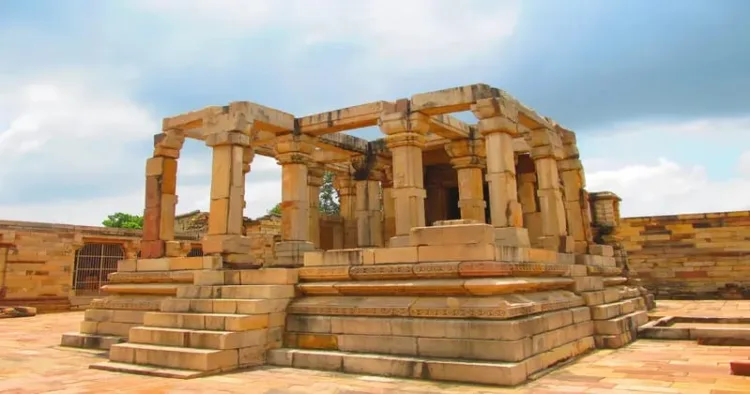As the city of the Sangam comes alive with the festivities of the Mahakumbh, it’s an opportunity to look back at the origins of the iconic pillar and explore other historical sites that reveal Prayagraj’s rich ancient heritage.
Within the walls of Prayagraj’s fort stands a pillar that serves as a silent witness to the region’s rich history. Originally erected by Emperor Ashoka, the pillar bore his inscription, marking the Mauryan era. Centuries later, during the Gupta period, another powerful emperor added his own message to the pillar. Over a thousand years later, during the Mughal reign, Emperor Jahangir encountered the pillar. Not only did he inscribe his words on it, but he also had it uprooted from its original site and relocated to the fort at Prayagraj, preserving its legacy for generations to come.
Kaushambi (56 kilometres southwest of Prayagraj): The pillar now standing in the Prayagraj Fort originally came from the extensive archaeological site at Kaushambi. A second pillar remains at the excavation site, which is situated along the Yamuna River. Exploration of the area began in 1861 with Major General Alexander Cunningham, and digs have continued sporadically since then. These excavations have uncovered a sprawling urban centre, revealing up to 15 layers of ancient settlements, with habitation dating back as far as 1000 to 800 BCE.
According to Buddhist texts, Kaushambi was once the capital of the Vatsa kingdom, ruled by King Udayana, who was a contemporary of the Buddha. These texts also mention that the Buddha visited Kaushambi in 521 and 518 BCE, having been invited to deliver a discourse by either a queen or a minister of Udayana.
According to a Chinese version of the Buddhist text Anguttara Nikaya, King Udayana commissioned the creation of an image of the Buddha, potentially the first such representation of the spiritual figure, which later spread beyond India. Some accounts even mention the renowned Chinese traveller Hiuen Tsang, who returned to China with an image of the Buddha from Kaushambi. If these accounts are accurate, this could be Kaushambi’s most significant and far-reaching contribution to history.
Garhwa (25 km south of Prayagraj): A cluster of ancient temples stands within a medieval fortification at Garhwa. While the fortifications were constructed in the late 18th century by Vikramaditya, a local Baghel ruler, the temples date back to the Gupta period. Despite their ruinous state, the temples still bear traces of iconography and several inscriptions. Excavations in the 1870s by Cunningham uncovered a series of 5th-century CE Sanskrit inscriptions, confirming the site’s Gupta origins.
The highlight at Garhwa lies within an enclosed storage space—a priceless collection of depictions of Vishnu’s ten incarnations, or Dashavatara. Carved individually on massive 6-7 feet high stone slabs, each depiction is a unique masterpiece. Alongside these, numerous fragments of the Saptamatrikas, the seven Goddesses from Hindu belief, are also preserved. Additionally, there are large stone sculptures of Brahma, Vishnu, Shiva, and an imposing figure of Surya. One can only imagine the grandeur of the temple to which these remarkable pieces once belonged.
Bhita (1 km from Garhwa): Today, Bhita appears as a vast green expanse dotted with low hills. The first formal exploration of the site occurred in the 1870s under the renowned Cunningham. Upon closer inspection, many of the overgrown ‘hills’ were revealed to be high walls, likely constructed for defensive purposes to accommodate a garrison.
Cunningham’s initial exploration set the stage for more extensive excavations three decades later. As John H. Marshall, Director-General of the Archaeological Survey of India (1902-28), noted, “The excavations at Bhita…mark a new chapter in Indian archaeology; they represent the first serious attempt to explore the remains of an ancient Indian town.” The subsequent excavations revealed well-preserved housing blocks along multiple streets. Some houses, comprising up to fifteen rooms, were arranged around a large open courtyard. These structures were equipped with drains, wells, and storage jars, providing valuable insights into the urban living conditions of that era.
The houses at Bhita, dating back to the Mauryan and Post-Mauryan periods, offer a remarkable glimpse into ancient town planning—an example that could inspire modern urban development in India. Among the key discoveries at the site was a Mukhalinga, a unique Shivlinga with five faces, dated to the 2nd century BCE. This rare find is considered one of the oldest lingas ever unearthed, adding to the historical significance of Bhita’s excavation.
Ginja Hill (about 12 km south of Garhwa): While the heritage of the previous sites remains somewhat hidden, the heritage of Ginja Hill is largely lost to time. According to the ASI’s description, it features a rocky hall on the southern face of the hilltop, bearing a three-line inscription from the Indo-Scythian period, written in red paint, alongside crude depictions of men and animals.
The site is not listed on Google Maps, so finding it requires some persistence and local inquiries. Located near the village of Bara Khas, Ginja is a small settlement with only a few hundred residents. The historic site sits on a small hill outside the village, marked by a blue protective sign.
The Indo-Scythians, or Sakas, were influential in the Subcontinent between the 2nd century BCE and the 4th century CE. However, nothing on Ginja Hill matches the description of an inscribed slab from their era. Atop the hill are two shrines: one, largely in ruins, likely dates from the 10th–12th century Chandela period, while the other is a more recent Hanuman shrine. Scattered around are broken fragments that resemble temple remains, but searching for the ancient inscription proves futile. One can only hope the inscription has been preserved in a museum rather than lying forgotten amidst the rubble. These sites, along with others like Shringverpur and Sujawan Dev, contribute to the rich history of Prayagraj. Inside the city, aside from the iconic Allahabad Museum, little of this ancient past remains. While millions flock to the city of the Sangam, only a few venture to these forgotten corners of history.



















Comments